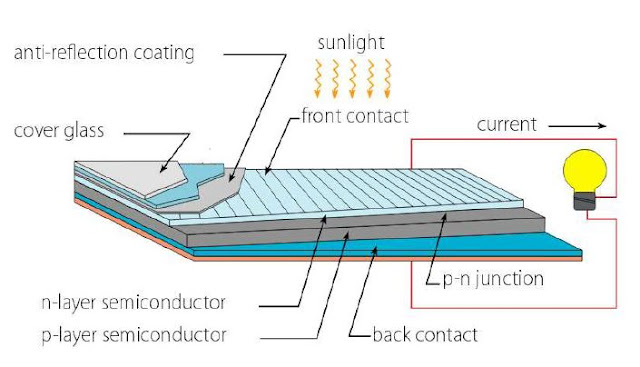Introduction
The earth receives about 174 petawatts [10^15 watts] of solar radiations from the sun and the total amount of energy absorbed by the earth’s atmosphere, oceans, the landmass is about 3,850,000 exajoules [10^18 joules] per year. The energy reaches the earth’s atmosphere consists of about 8% of UV radiation, 46% of visible light, 46% infrared radiations. So, it is better to utilize this free energy that we receive from the sun in the most efficient way to fulfill our electricity needs. Also, it is the non-polluting renewable source of energy.
What is a Solar Cell?
A solar cell or photogalvanic cell is a solid-state electrical device that converts the energy of light or solar energy directly into electricity by the photovoltaic effect. A solar cell is also called a photovoltaic cell or photoelectric cell.
The term “photo” comes from the Greek word "phos", which means “light”. The “voltaic” means "producing the electric current", the word came from the name of Italian physicist Alessandro Volta.
The term photovoltaic means, "creating electrical energy when exposed to light."
Photovoltaic Effect
It is the generation of voltage or electric current across the PN junction of a semiconductor due to the absorption of light radiation is called the photovoltaic effect.
In the solar cell, electricity is produced by using the photovoltaic effect.
When sunlight hits the silicon metal cell, the photon energy allows the electrons from the p-layer to move to the n-layer which creates an electrical potential difference on the semiconductor borders. The n-layer has free electrons and the p-layer has free holes (the absence of electrons). So, when this p and n layers are connected to an external circuit, the electrons flow from n-layer to p-layer, and hence the current is generated. The electrons leave from the solar cell as current provides energy to whatever is connected to the solar cell, and then re-enter the solar cell and the process begins again by sunlight.
Applications of solar cells
Solar cells are used in a wide variety of applications. Some of them are,
- Satellites
- Toys, watches, calculators
- Electric fences
- Remote lighting systems
- Water pumping
- Water treatment
- Emergency power
- Portable power supplies
Advantages of solar cells
- It is a clean and non-polluting energy source.
- It is renewable energy.
- Solar cells do not produce noise for electricity generation.
- It requires very little maintenance.
- Long lifetime.
- There are no fuel costs or fuel supply problems in this electrical energy production.
Disadvantages of solar cells
- Intermittency issues during power generation.
- Require extra elements like batteries, inverters.
- High initial cost.
- It requires a large area for installation.
- It can be damaged easily.
Also read about: Solar Energy Collectors (Part 1)
Please follow the link to know about Solar cell types. If you want to know any of the types clearly through simple explanation, mention that in comments, I will explain in detail in this blog. Thanks!

Comments
Post a Comment